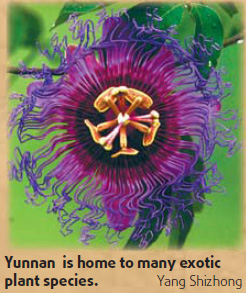Yunnan has given birth to some of China's greatest dancers, but you'll never guess who your next dance partner will be. It could be grass.
Scientists out on field trips noticed it when they relaxed in the woods and sang for self-enjoyment. The blades of one kind of grass would open or close at their sound. Now it has become a small attraction at the Xishuangbanna Tropical Botanical Garden (XTBG) where tourists stand around and sing to troves of these grasses.
Like everything else here, there is a story behind it. A long time ago, a Dai girl named Duoyi loved to dance. But the local brute got wind of it and forced her to dance for him every day. She resisted and jumped into the river. Upon her tomb began to grow gobs of grass that danced gracefully, just as she had done when alive.
The real reason, according to scientists, is the decibel level, which should be between 35 and 65. Actually, sunshine can also send it boogie. The grass is a distant relative of the pea, but I guess peas know their fate lies in being eaten by humans so they don't have the heart to do a jitterbug.

There are 10,000 plants in the garden, which sit on 900 hectares of a peninsula. It is surrounded on three sides by the Luosuo River. The western area, which looks like a gourd, is trimmed and spruced for tourists while the much vaster eastern area remains mostly pristine rainforest, with only a few trails.
But even the smaller area takes a full day to explore. There is a 2,000 sq m museum. There are special areas for plant families, such as the bamboo garden, the aquatic plant garden, the ficus garden, the arboretum, the palm garden, the medicinal plant garden, the cycad garden, the vine garden, the dracaena garden, among others.
If these names intimidate you, you can simply enjoy the plants for their aesthetic value. There's one kind of flower that, when in bloom, looks like Buddha sitting on a lotus. Another kind of yellow flower is used as offerings in temples and local girls also wear it on their heads. Its roots can be made into dye for monks' kasaya or robe.
The palm garden is made with materials from palm trees, with leaves as thatches for example. Elsewhere, there are lotus leaves so huge a 15-kg kid can sit inside. There is a black flower that grows "whiskers" like a cat. There is a hanging garden where the flowers are seeded by birds. There is the lightest tree, with its wood used in aircraft interiors, and the heaviest tree. As you wander through this tropical wonderland, your senses are constantly amazed by new discoveries.
If you say this garden is perfect for learning about botany, you've hit the right note. It started, in 1959, as a field for scientists. Led by Professor Cai Xitao, generations of botanists labored all their lives to turn a six-household "ghost village" into one of the nation's largest botanical gardens. Now it has become the "gem" in the crown of the kingdom of flora.

